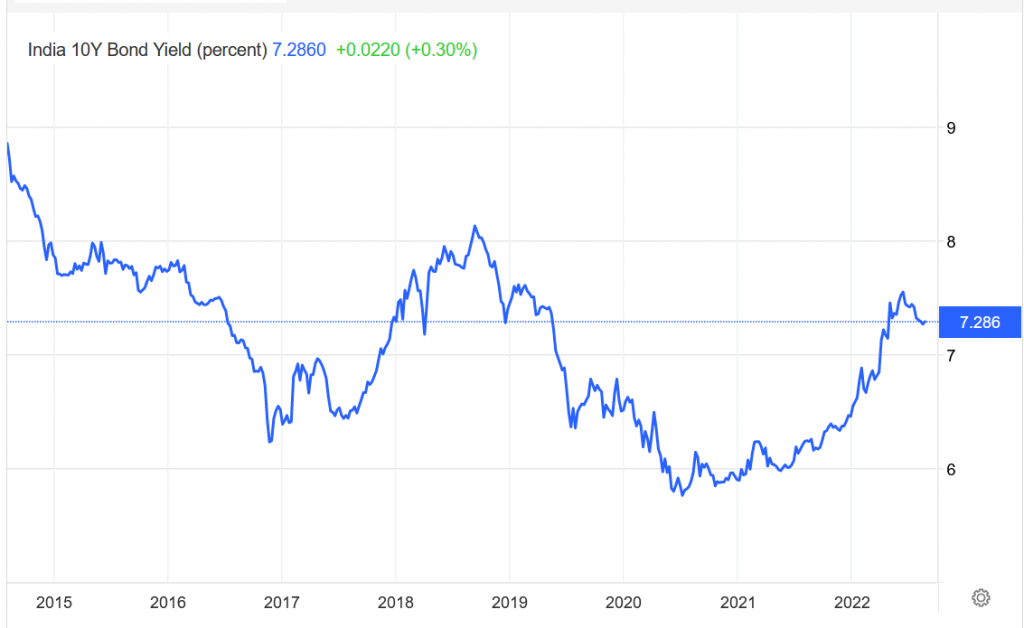Since the start of the conflict between Russia and Ukraine, the world has been going through a financial crisis. The conflict is one of the main causes of the catastrophe, however, it may not be the sole one. Similar to this, one of the worst worldwide financial crisis of 2008 was brought on by Lehman Brothers’ collapse. The world market had taken some time to return to normal, and now that it has, the current crisis has severely affected every region of the globe.
The effects of the war are causing severe inflation in the affected nations, and the US, one of the world’s largest financial markets, just recorded inflation of 9.1%, which is the highest level since 1981.India reported 6.7% inflation for the fiscal year 2022-2023 in the meantime.
Inflations of this kind do in fact have a disproportionately negative influence on the ordinary individual, from their purchase decisions to their investing strategies. Despite the fact that bonds are thought to be less hazardous than the stock market, the general public is confused about how inflation affects bond prices when trying to select whether or not to invest in one of these financial instruments. Let us understand
What is inflation?
Costs for products and services are rising throughout all economic sectors, which is referred to as inflation. Inflation has the consequence of making money less valuable.
You may buy less with your money when inflation increases. The Consumer Price Index is used to calculate inflation (CPI). The CPI monitors changes in product and service prices over time.
If, for instance, you paid Rs 50 for a product last year and the rate of inflation increases to 6%, you would now pay Rs 53 for the exact same product this year due to increased pricing. Your purchasing power decreases as inflation rises.
The price of an LPG cylinder was Rs. 859 last year; the current market price is Rs. 1013.
How does diversification help the investor to grow their portfolio?
Inflation history in India
 source- statista.com
source- statista.com
What is the role of the RBI ( Reserve Bank of India)
Based on the inflation rate, the market activity is mostly determined by the Reserve Bank of India. If the rate of inflation rises, the Reserve Bank will increase interest rates to stifle economic expansion and service demand. The RBI will reduce interest rates if inflation falls below the acceptable threshold. It boosts the amount of money available to the financial system by doing so.
How does inflation impact bond prices?
It is alleged that whenever inflation affects the market, interest rates have steadily increased in all areas of financial activities, including purchasing and investing. Similar to securities, when interest rates are increased, bond prices down; conversely, when interest rates are lowered, bond prices increase. The cost of bonds and interest rates are inversely correlated.
Here is an instance. Consider purchasing an 8 percent coupon, 10-year high-yield corporate bond before inflation starts to affect the market.But four years later, when inflation hit the market, the issuer increased the interest rate for the identical bond to 10% in an effort to remain competitive in the inflated market environment. You won’t get the same price for your bond if you decide to sell it now as when you bought it. Due to the availability of new bonds with greater interest rates, investors won’t pay you as much for your bond. Your bond’s value will decrease until its yield-to-maturity is equal to the current rate of the bond market.
Also true in reverse. When interest rates decline, an existing bond’s market price will increase enough to bring the coupon rate down to the current market rate.
Read our previous blog on What is the relationship between bond prices and interest rates? Understand the inverse relationship between bond price and interest rate.
Recent trends – Yield on bonds in India
The repo rate has been increased by 50 basis points at the Reserve Bank of India (RBI) from 4.9% to 5.4% this year. As a result, 10-year Treasury yields increased to their highest level in Jan to May and have been declining in recent months.. It was the customary course of action to address growing inflationary pressures.
The Government of India (GOI) and the RBI set a 4% % annual inflation target until the end of the year, with a 2% tolerance on both sides, but the actual annual inflation rate of 6% remained above during the last three months.
It is anticipated that the RBI may raise interest rates once more in the upcoming months as it attempts to limit the amount of liquidity in the banking system in order to reset the inflation trajectory downward once more. This tendency is not exclusive to India; growing yields are observed in other countries as well. To combat inflation, the Federal Reserve Bank, for instance, raised its benchmark interest rate by 50 basis points on the same day as the RBI’s announcement. This was the largest increase in the US in the past 20 years.
Given below is a snapshot of the Indian government bond yields over the years.

source- tradingeconomics.com
According to a Reuters poll of traders, the RBI has so far sold 130 billion rupees ($1.63 billion) of a new 10-year bond at a cutoff yield of 7.26%, versus forecasts of 7.23%.
The band initially traded at a discount but concluded at 100.05 rupees, yielding 7.2529%.
Your long-term investments’ value will always be slowly being eaten away by inflation, which is a stealthy parasite. You will be able to stay one step ahead of it with some preparation.
Why should you invest in Fixed income in the volatile Market ?






